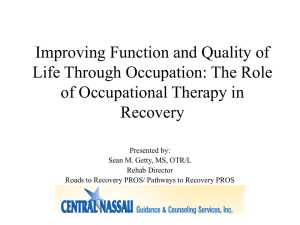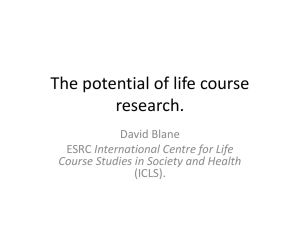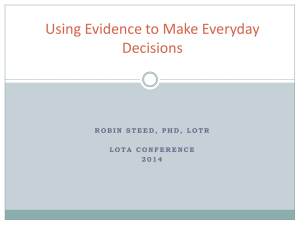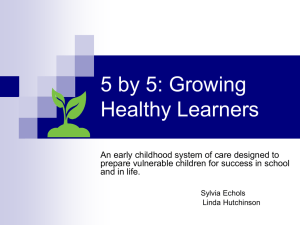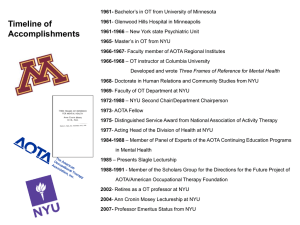OT and EC Transition Webinar FINAL-8-26-13
advertisement
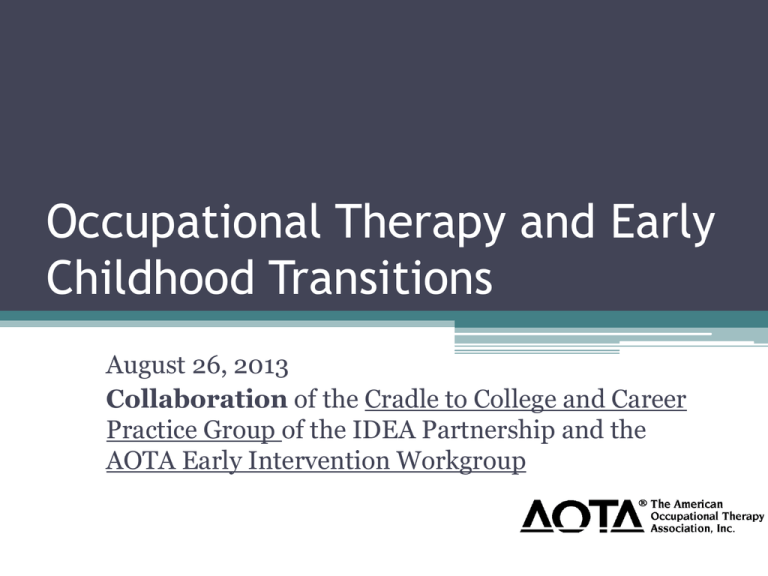
Occupational Therapy and Early Childhood Transitions August 26, 2013 Collaboration of the Cradle to College and Career Practice Group of the IDEA Partnership and the AOTA Early Intervention Workgroup Speakers • Kathleen Flecky, OTD, OTR/L earned an Occupational Therapy Doctorate (OTD) from Creighton University and has taught occupational therapy and health coursework for over 10 years. She has worked in schoolbased and community occupational therapy practice. Kathy has published, received external and internal grant funding and presented research and workshops on infant mental health, children/family healthy lifestyles and community partnerships. She has interdisciplinary experience teaching students from the fields of occupational therapy, nursing and physical therapy. • Christine Myers, PhD, OTR/L is an Associate Professor in the Eastern Kentucky University Department of Occupational Therapy. She has an established line of research related to transition services for young children and families. She previously provided services to infants, toddlers, and preschoolers in a variety of hospital-based and community settings. She is coordinator of the Transition to Preschool Program and serves on the American Occupational Therapy Association's Transition Workgroup. Speakers • Phyllis Mondak, MS, M.Ed. serves as the Early Childhood Special Education (619) Coordinator for Virginia's Department of Education. She supports the Part C programs, school divisions, and state technical assistance centers early childhood initiatives. She previously was a special education coordinator and teacher in public schools and a developmental specialist in local Part C programs. She has also worked with Head Start as a local education/disabilities coordinator. She is an adjunct professor for Virginia Commonwealth University. • Arezou Salamat, OTD, OTR/L is an assistant professor at Loma Linda University, CA., Department of Occupational Therapy. Her emphases are in research, teaching and mentoring master level occupational therapy students in working with young children and their families. Dr. Salamat currently works in a countywide community based mental health program with children under age of five who experienced maltreatment or prenatal exposure to narcotics and alcohol. Dr. Salamat believes in empowering caregivers and identifying strategies to support meaningful relationships through community integrations and active participation in daily routines to promote overall health and well being of a child and community inclusion. Speakers • Sandra Schefkind, MS, OTR/L is the Pediatric Coordinator in the Professional Affairs Division at AOTA. In this capacity she is responsible for various association and national office activities and projects related to occupational therapy practice, representing AOTA with pertinent external organizations, and providing technical assistance and guidance with practice based inquiries. • Ashley Stoffel, OTD, OTR/L is a Clinical Assistant Professor at the University of Illinois at Chicago where she leads and contributes to the pediatric content of several courses. Her scholarship is aimed at implementing family-centered early intervention and children’s services in community settings to individuals from diverse backgrounds. Ashley also works clinically at Aspire Children's Services in west suburban Chicago, where she provides family-centered early intervention and specialized services to children and families. Ashley is a member of the AOTA early intervention workgroup and co-leads the Cradle to College and Career practice group of the IDEA partnership. Poll • Who is participating on the webinar? • What state are you from? • Welcome • AOTA is an active member of the IDEA Partnership – collaborating – building networks – disseminating resources – monitoring value – Pediatric Occupational Therapy Practitioners convene by teleconferencing to conduct shared work on key focus areas. Goal is to promote best practices. Questions? Contact Sandy Schefkind at sschefkind@aota.org Early Childhood Workgroup AOTA Members: We want you to join a Community of Practice Autism Workgroup http://www.aota.org/governance/leadership.asp x Accomplishments Include: • • • • • • FAQ: What is OT’s Role in Supporting Persons With an ASD? Pediatric Virtual Chat discussing the new FAQ Tip Sheet for Caregivers: Living with an ASD – The Preschool Child AOTA Resources: Challenges and Opportunities for Children and Youth with an ASD Virtual Chat led by Students with an ASD OCALICON presentation Tip Sheet: Building Play Skills for Healthy Children and Families • Pediatric Virtual Chats on Bullying Prevention and Promoting Play • FAQ on School Mental Health • Leadership at Advancing School Mental Health Conference cosponsored by IDEA Partnership • Children’s Mental Health Awareness Day Activities • Online School Mental Health Toolkit 2013 • Recess Promotion Powerpoint • • • • • • Stars indicate workgroup members from around the country School Mental Health Workgroup Accomplishments Include: Accomplishments Include: See the AOTA page of the IDEA Partnership web site www.sharedwork.org Response to Intervention (RtI) Workgroup Transition Workgroup Accomplishments Include: • • • • • • • • • OT Practice Article on RtI Consumer Brochure on RtI Pediatric Virtual Chat on RtI Practice Advisory on RtI Speaking with various audiences about RtI Virtual Chat Accomplishments Include: • • • FAQ on Transitions Fact Sheet on Transitions Transition Checklist Two virtual chats on early childhood and high school transitions OT Practice article Transition powerpoint New Cradle to College & Career Practice Group established • FAQ: What is the Role of Occupational Therapy in Early Intervention? Contributed to Practice Advisory on Early Intervention Pediatric Virtual Chat on the Practice Advisory Supported work related to CDC’s Learn the Signs Act Early Campaign FAQ for practitioners on dialoguing with families with cultural sensitivity in development Early ID signs of autism chat Obesity Prevention Workgroup Accomplishments Include: • • • • Edited new Obesity Prevention Information Sheet for School Mental Health toolkit Virtual chat on childhood obesity AOTA Conference Presentations Tip sheet on obesity OT Consultants in State Dept of Education Accomplishments Include: • • Trifold on OT role in school practice for administrators Trifold for consumers in development Living Life to its Fullest® OCCUPATIONAL – collaborating – building networks – disseminating resources – monitoring value – advancing practice building community – T H E– RA PY – leading by convening – crossing national/state/local levels – collaborating – building networks – – leading by convening – crossing national/state/local levels – collaborating – building community – disseminating resources What is Occupational Therapy? • Occupational therapy promotes function and engagement in daily habits and routines. …the “occupation” of life skills… ▫ What is an occupation? Areas of Occupation (AOTA, 2008) • • • • • • Activities of Daily Living Rest and Sleep Work Play/Leisure Social Participation Education Meaningful Occupations • Infant/toddler ▫ Play • Young child ▫ School/ Student ▫ Peer/Friend ▫ Dancer/Soccer player • Adult ▫ Job ▫ Family Member ▫ Hobby Poll • HAVE YOU EVER COLLABORATED WITH AN OCCUPATIONAL THERAPY PRACTITIONER IN THE FOLLOWING AREAS? ▫ Autism (addressing sensory processing, assistive technology, social participation) ▫ School Mental Health (addressing bullying, obesity, depression) ▫ Transitions (EI to EC; EC to Kindergarten) ▫ Response To Intervention (RTI) ▫ Other areas (write responses in the chat) ▫ I have collaborated with an occupational therapy practitioner in more than one of these areas ▫ I have never collaborated with an occupational therapy practitioner What are early childhood transitions? • Part of life for all children and families ▫ Starting with hospital to home • Children with delays or disability ▫ Part C and/or Part B services under IDEA (Individuals with Disabilities Education Act) ▫ Early Intervention to Early Childhood (EC) program ▫ EC program to Kindergarten What is the role of OT in early childhood transitions? • Collaborate with families to support understanding of the next steps and changes in roles/routine and promote advocacy and empowerment • Assist with preparing the child prior to the transition and to perform needed skills • Evaluate the child’s needs in order to support participation in the next setting • Collaborate with the entire team What are some basic concepts and evidence? How do they translate to practice? Families, Children, and Transitions: Key Evidence-Based Findings ▫ Transition is a complex process, not a static event, that creates stress for families (Fowler, Chandler, Johnson & Stells, 1988; Fowler, Schwartz & Atwater, 1991; Hanson, et al., 2000; Rice & O’Brien, 1990; Rosenkoetter et al., 1994) ▫ Stress may be decreased through planning and support from service providers (Hamblin-Wilson & Thurman, 1990; Hanline, 1988; Hanline & Halvorsen, 1989; Lazzari & Kilgo, 1989; McDonald, Kysela, Siebert, McDonals & Chamber, 1989) Families, Children, and Transitions: Key Evidence-Based Findings ▫ Positive working relationships between service providers and families is the most crucial factor in a successful transition to an inclusive environment for children with disabilities (Kemp, 2003; Rosenkoetter, et al., 2009) ▫ Families must have their needs met first before they can help their children with disabilities transition between programs or systems (Rosenkoetter, et al., 2009) Families, Children, and Transitions: Key Evidence-Based Findings ▫ Close, positive teacher-child relationship during transition correlates with better cognitive outcomes for typical and at-risk children and social relationships for typical children (Mantizicopoulos, 2005; Peisner-Feinberg et al., 2001; Silver, et al., 2004) ▫ Preparatory activities support positive transition outcomes for children (Chandler, 1993; Hains, Fowler, & Chandler, 1988; Kemp & Carter, 2000; Rice & O’Brien, 1990; Rule, Fiechtl & Innocenti, 1990) Strategies that Support Children and Families include: (Rosenkoetter, et al., 2009) • Providing information on options for placements • Shared information about next environment • Honest information about child levels and expectations • Liaisons between programs • Parent training in advocacy • Program visits • Supplemental community services • Parent participation on transition planning teams • Linkages with other families • Follow-up support after transition Occupational Therapy Transition Strategies for Families and Children: BEFORE the move (Myers, 2006; 2008; Podvey & Hinojosa, 2009) • Engage in occupation-based assessment with families to determine priorities for transition • Establish skills necessary for engaging in occupations in the next environment • Create opportunities for families and children to familiarize themselves with elements of the receiving environment (e.g., play groups) • Create opportunities for families to gain access and knowledge about available community resources OT Transition Strategies for Families and Children: BEFORE the move (Myers, 2006; 2008; Podvey & Hinojosa, 2009) • Prevent performance problems in the next environment by: ▫ Discussing the transition process with families in order to anticipate potential issues and solve problems early ▫ Visiting the receiving environment with the child and families to assess for potential issues prior to the actual transition ▫ Meeting with the family and other team members from the next environment to discuss specific expectations ▫ Participating in transition conferences, IFSP development, and IEP development OT Strategies for Families and Children: AFTER the move (Myers, 2006; 2008; Podvey & Hinojosa, 2009) • Modify the context or task in the new environment to support participation • Alter the context as needed to support engagement and ease the child into the new environment • Work with children and families to help them adjust their roles and routines and understand the roles and routines in the new environment OT Strategies for Families and Children: AFTER the move (Myers, 2006; 2008; Podvey & Hinojosa, 2009) • Help families understand how their child’s strengths and challenges fit into the new environment • Consistently collaborate with families and teachers after the move to the new environment, especially in the early days as the child and family are in a critical period of adjustment • Link school-based intervention to issues at home in order to create a connection between both environments Early Childhood, Evidence-Based Practice and Occupational Therapy • The American Journal of Occupational Therapy- special issue on early intervention/early childhood (July/August 2013) • Frolek-Clark, G. & Kingsley, K. (2013). Occupational therapy practice guidelines for early childhood: Birth through 5 years. Bethesda, MD: AOTA Press. • Chandler, B. (2010) Early childhood: Occupational therapy services for children birth to five. Bethesda, MD: AOTA Press. • Myers, C. & Podvey, M. (2013). Early childhood transitions. In B. Chandler & G. Frolek-Clark, (Eds.), Best Practices in School Occupational Therapy. Bethesda, MD: AOTA Press. What are some examples that show how occupational therapy contributes to successful transition for young children and their families? Poll • Do you regularly attend? ▫ Part C transition conferences ▫ Part B eligibility meetings ▫ Part B initial IEP meetings ▫ Check all that apply OT and Part B Services • OT role in eligibility for Part B preschool services • Initial IEP recommendations ▫ ▫ ▫ ▫ Accommodations to the child's environment Positioning Visual supports for schedules Self-help skills-feeding CONNECT Modules http://community.fpg.unc.edu/ Modules Module Topics • • • • • • • Embedded Interventions Transition Communication for Collaboration Family-Professional Partnerships Assistive Technology Dialogic Reading Practices Tiered Interventions Infant Mental Health and Transitions • Enhancing a healthy, positive relationship between a child, siblings, family and caregivers is an important aspect of occupational therapy’s domain of practice in the promotion of health for children and families and infant mental health (IMH) (AOTA, 2008) American Occupational Therapy Association (2008). Occupational therapy practice framework: Domain and process. (2nd ed.). American Journal of Occupational Therapy, 62, 6, 627-630. What is Infant Mental Health? • IMH relates to the socio-emotional development and well-being of the child through family-centered mental health intervention and prevention of childhood mental health issues (Hinshaw-Fuselier, Zeanah, & Larrieu, 2009). • It is a growing interdisciplinary field in health care! • Hinshaw-Fuselier, S., Zeanah, P. D., Larrieu, J. A. (2009). Training in infant mental health. In C. H. Zeanah (Ed.), Handbook of infant mental health (3rd ed., pp. 533-548). New York: Guilford Press. IMH and Transitions • Occupational therapists have expertise in IMH and are key members of interdisciplinary teams who provide infant mental health services in transitional planning and intervention. • Ways occupational therapists can gain or enhance IMH expertise include: participating as part of an early childhood mental health coalition in your area, joining your state infant mental health association, workshops on relationships, resilience, at risk children and parents; completing a certificate in infant mental health; locating a mentor in the field of infant mental health. Story of Sam & Emily • Sam is 3 years old with history of failure to thrive, feeding difficulties and possible FAS; • Emily is 22 years old with history of depression and substance abuse; • Transition from home to preschool pending; • OT’s impression of Johnny’s behavior in transitioning from home to preschool; • The impact of this transition for Sam and Mother Emily’s daily routines and healthy caregiver relationships OT role in setting up a successful transition-Sam • Strategies for meeting Sam’s needs through interdisciplinary problem-solving of Sam’s strengths and areas of limitation in capacities and skills for successful preschool participation; • Strategies for enhancing Emily’s abilities to anticipate Sam’s needs for transition; • Strategies for building communication and a healthy, socio-emotional bond with all caregivers. Examples of OT Role in Transition • Transition to foster home • Transition from NICU to home Story of Johnny • A 23-month-old boy • Removed from care of biological mother due to history of neglect and malnutrition. • Transition from biological mother to foster home • Foster mother described Johnny as “quiet”, “easy baby” who just sleeps a lot. • OT’s impression of Johnny’s behavior in transitioning to a new home. • The impact of this transition to Johnny’s daily routine OT role in setting up a successful transition-Johnny • Working directly with foster parents to create a safe and secure attachment by actively engaging in childhood occupations (activities). • Create a daily routine that promotes all childhood occupations. • Promoting “co-occupations” and having foster parents play, eat, and go on outings together rather than going out around Johnny’s sleeping schedule. • Allowing Johnny to explore his new environment by actively taking him to each room of the house slowly over a few days so he can get familiar with his new “home”. • Decorate his room with him Story of Jasmine • A 2-month-old infant who was discharged from NICU to home • Parental concerns: ▫ Readiness ▫ Excitement ▫ Nervous • What happened at home? • OT’s impression of Jasmine’s behavior in transitioning to home OT role in setting up a successful transition-Jasmine • Consult with pediatrician/medical team about any medical or nutritional concerns with her spitting up. • Continue using successful calming techniques that the family learned in the NICU • Support parents in being aware of their own state of arousal • Maintain calm • Evaluate the environment ▫ Decrease the stimulation in Jasmine’s room and her crib. ▫ She basically moved from a quiet environment to an environment with colors, sounds and noises. • Decrease and monitor the number of visits by family and friends • Introduce one toy at a time and allow Jasmine time to explore the toy by looking or attempting to reach. What resources are available to share? • AOTA Transition resources http://www.aota.org/Practice/ChildrenYouth/Transitions.aspx • AOTA Tip Sheet for Parents: Transition to Preschool for Children with Autism (in press) • AOTA Early Intervention http://www.aota.org/en/Practice/ChildrenYouth/Early-Intervention.aspx • National Early Childhood Transition Center http://www.hdi.uky.edu/nectc/NECTC/Home.aspx ▫ Tool kit lists transition activities Transition TIPS http://www.hdi.uky.edu/nectc/NECTC/practicesearch.aspx Resources continued • Early Childhood TA Center www.ECTAcenter.org ▫ (Part C to Preschool) http://ectacenter.org/topics/transition/transition.asp ▫ (Preschool to Kindergarten) http://ectacenter.org/topics/transtoK/transtoK.asp Resources continued • Article: “Understanding Early Childhood Transition: A Guide for Families and Professionals” by the Early Intervention Subcommittee of the North Dakota Interagency Coordinating Council www.dpi.state.nd.us/speced/early/guide.pdf • World Association of Infant Mental Health http://www.waimh.org/i4a/pages/index.cfm?pa geid=1 • Zero To Three http://www.zerotothree.org/ Resources continued • Head Start Early Childhood Knowledge and Learning Center (Training and TA) ▫ Parent, Family, and Community Engagement http://eclkc.ohs.acf.hhs.gov/hslc/ttasystem/family/center ▫ Quality Teaching and Learning Center http://eclkc.ohs.acf.hhs.gov/hslc/tta-system/teaching • Special Quest Multimedia Training Library http://ncoe.pointinspace.com/trainingmaterials/ What are some action steps? • • • • Share fact sheets on EC Ask an OT to do an in-service Share the link to this webinar Contact state or national OT organizations ▫ www.aota.org • Access and be active on sharedwork ▫ www.sharedwork.org Thank you! • Kathleen Flecky, OTD, OTR/L • Kristin Hildebrand, MSOT, OTR/L • Phyllis Mondak, MS, M.Ed; Va. Dept of Education • Christine Myers, PhD, OTR/L • Arezou Salamat, OTD, OTR/L • Sandra Schefkind, MS, OTR/L; AOTA Pediatric Coordinator • Ashley Stoffel, OTD, OTR/L References • Chandler, L. K. (1993). Steps in preparing for transition: Preschool to kindergarten. Teaching Exceptional Children, 25(4), 52-55. • Fowler, S. A., Chandler, L. K., Johnson, T. E., & Stells, E. (1988). Individualizing family involvement in school transitions: Gathering information and choosing the next program. Journal of the Division for Early Childhood, 12(3), 208-216. • Fowler, S. A., Schwartz, I., & Atwater, J. (1991). Perspectives on the transition from preschool to kindergarten for children with disabilities and their families. Exceptional Children, 58(2), 136-145. • Hains, A. H., Fowler, S. A., & Chandler, L. K. (1988). Planning school transitions: Family and professional collaboration. Journal of the Division for Early Childhood, 12(2), 108-115. • Hamblin-Wilson, C., & Thurman, S. K. (1990). The transition from early intervention to kindergarten: Parental satisfaction and involvement. Journal of Early Intervention, 14(1), 55-61. • Hanline, M. F. (1988). Making the transition to preschool: Identification of parent needs. Journal of the Division for Early Childhood, 12(2), 98-107. • Hanline, M. F., & Halvorsen, A. (1989). Parent perceptions of the integration transition process: Overcoming artificial barriers. Exceptional Children, 55(6), 487-492. References • Kemp, C., & Carter, M. (2000). Demonstration of classroom survival skills in kindergarten: A five-year transition study of children with intellectual disabilities. Educational Psychology, 20(4), 393-405. • Lazzari, A. M., & Kilgo, J. L. (1989). Practical methods for supporting parents in early transitions. Teaching Exceptional Children, 22(1), 40-43. • Mantzicopoulos, P. (2005). Conflictual relationships between kindergarten children and their teachers: Associations with child and classroom context variables. Journal of Social Psychology, 43, 425-442. • McDonald, L., Kysela, G. M., Siebert, P., McDonals, S., & Chambers, J. (1989). Parent perspectives: Transition to preschool. Teaching Exceptional Children, 22(1), 4-8. • Myers, C. T. (2006). Exploring occupational therapy and transitions for young children with special needs. Physical and Occupational Therapy in Pediatrics, 26, 73–88. • Myers, C. T. (2008). Descriptive study of occupational therapists’ participation in early childhood transitions. American Journal of Occupational Therapy, 62(2), 212-220. References • Peisner-Feinberg, E., Burchinal, M. R., Clifford, R. M., Culkin, M. L., Howes, C., Kagan, S. L., et al. (2001). The relation of preschool child-care quality to children’s cognitive and social developmental trajectories through second grade. Child Development, 72, 1534 1553. • Rice, M. L., & O'Brien, M. (1990). Transitions: Times of change and accommodation. Topics in Early Childhood Special Education, 9(4), 1-14. • Rosenkoetter, S. E., Hains, A. H., & Fowler, S. A. (1994). Bridging early services for children with special needs and their families: A practical guide for transition planning. Baltimore: Brookes. • Rosenkoetter, S., Schroeder, C., Rous, B., Hains, A., Shaw, J., & McCormick, K. (2009). A review of research in early childhood transition: Child and family studies. Technical Report #5. Lexington: University of Kentucky, Human Development Institute, National Early Childhood Transition Center. Available at http://www.hdi.uky.edu/nectc/NECTC/Home.aspx • Rule, S., Fiechtl, B. J., & Innocenti, M. S. (1990). Preparation for transition to mainstreamed post-preschool environments: Development of a survival skills curriculum. Topics in Early Childhood Special Education, 9(4), 78-90. • Silver, R. B., Measelle, J. R., Armstrong, J. M., & Essex, M. J. (2004). Trajectories of classroom externalizing behavior: Contributions of child characteristics, family characteristics, and the teacher-child relationship during the school transition. Journal of School Psychology, 43, 39-60.
